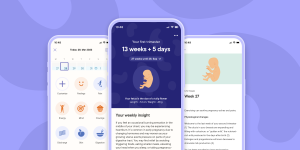Illustration by Marta Pucci
Deep diagnosis: A naturopathic approach to PCOS
This is part of a series of first-person articles by healthcare providers about how they approach PCOS. Read the first contribution by Dr. Shruthi Mahalingaiah.
As a naturopathic doctor with more than twenty years of experience in women’s health, my strategy for polycystic ovary syndrome (PCOS) is to treat the patient, not the PCOS label.
What do I mean by that? I mean that PCOS, as it is currently defined, is an umbrella diagnosis that encompasses a variety of underlying physiological drivers. In other words, PCOS is not one disease, and that’s why it’s such a confusing diagnosis. Some people benefit from the standard PCOS treatment, but others do not.
I take a more targeted approach.
If my patient has the classic insulin-resistant PCOS, then I prescribe diet, exercise and supplements to reverse insulin resistance. But if my patient does not have insulin resistance, I look at other types of treatment.
For each and every individual, I consider the following questions:
- Is it truly PCOS?
- Is it insulin-resistant PCOS?
- Is it a temporary “post-pill” situation?
1. Is it truly PCOS?
Getting a diagnosis of PCOS requires a patient to meet certain criteria, with the Rotterdam diagnostic criteria being commonly used. Under the Rotterdam criteria, PCOS is diagnosed based on the presence of irregular ovulation, high androgens (male sex hormones), and/or polycystic ovaries. Under other criteria, such as the Androgen Excess and PCOS Society (AE-PCOS), PCOS cannot be diagnosed unless both high androgens and ovulation dysfunction are present. The AE-PCOS criteria do not permit diagnosis based only on irregular ovulation and polycystic ovaries (1).
Although the finding of polycystic ovaries is currently accepted by some experts as helpful for diagnosis, many other experts question its value because polycystic ovaries are a normal finding in a third of all women, especially younger women (2). In fact, the new International Evidence-Based Guidelines for PCOS recommends polycystic ovaries no longer be used to assess women within eight years of the start of periods (3). They go on to state that the very word polycystic “is a misnomer” because it refers to ovarian follicles (eggs), which are normal for the ovary, and are not abnormal structures like other types of pathological ovarian cysts (3). Neither polycystic ovaries nor the hormonal condition PCOS is a cause of pain.
According to a recent study, the inclusion of polycystic ovaries as a diagnostic criterion may have resulted in overdiagnosis of PCOS and unnecessary distress and worry for patients (4). The same paper concludes that for at least some women, PCOS is a temporary situation that might be outgrown (4). Another study raises the concern that the current diagnostic approach is routinely misdiagnosing PCOS in women who actually have hypothalamic amenorrhea, a condition caused by under-eating (5).
In my own clinical practice, I follow the AE-PCOS criteria and am not satisfied with a PCOS diagnosis unless my patient has clear signs of high androgens either on a blood test or with clinical signs such as facial hair.
Once I am satisfied that my patient truly does have PCOS, then I move on to the next question.
2. Is it insulin-resistant PCOS?
Insulin resistance or high insulin is the major driver of the classic type of PCOS, and almost all of the best-known treatments including diet, metformin, and inositol work by reversing insulin resistance and thereby reducing PCOS symptoms. Insulin resistance is present for most women with PCOS, but not every woman with the diagnosis. That’s why it’s important to test.
With my patients, I confirm insulin resistance with a blood test for the hormone insulin, like the glucose tolerance test with insulin. With this test, several blood samples are taken during the two hours after drinking a sugary (glucose) drink. From these blood samples, the changes in both glucose and insulin can be measured.
If my patient does have insulin resistance or high insulin, then I prescribe exercise and diet to reverse insulin resistance. That includes the recommendation to reduce high-dose fructose as described in my PCOS and insulin post. I also prescribe magnesium and the evidence-based natural medicine inositol.
If my patient does not have insulin resistance, then I consider whether it is a temporary post-pill situation (see below) and I do further testing to detect less common variants of PCOS, such as PCOS that primarily involves the adrenal or stress glands.
The adrenal glands sit on top of each kidney and produce a number of hormones including the stress hormone cortisol and androgens. For most PCOS patients, both the adrenal glands and the ovaries are the source of excess androgens, but for a small subset of PCOS patients, the adrenal glands play a larger role (6). When I observe high levels of adrenal androgens, my clinical strategy is to prescribe traditional herbal and nutritional treatments to stabilize the stress response, and thereby potentially modify the hormone output of the adrenal glands. There is not yet much research in this area.
3. Is it a temporary “post-pill” situation?
If my patient does not have insulin resistance or the adrenal androgen variant of PCOS, then my next question is “what were your periods like before the pill?” The drug-withdrawal bleeds on the pill are not real periods, so I’m interested in how my patient’s natural menstrual cycles were before taking any kind of hormonal birth control.
If my patient’s menstrual cycles were regular and fine before taking birth control, then I consider that it could be a temporary situation of "post-pill" PCOS. There is some evidence that stopping oral contraceptives can cause a short-term delay of fertility, but there has not yet been research into the possible condition of "post-pill" PCOS that I observe with some patients. I observe it in women who started certain types of oral contraceptives while still young, and then experience both a delay in re-establishing regular ovulation and a temporary surge in androgens and androgen-excess symptoms, such as acne.
If I determine that my patient is in a temporary “post-pill” PCOS situation, then I offer reassurance that it could resolve on its own after one to two years. I also offer zinc and dietary changes to deal with post-pill acne. I sometimes prescribe a course of traditional herbal medicines to reduce androgens and attempt to re-establish ovulation.
Lara Briden is a naturopathic doctor with more than twenty years of experience in women’s health. She is the author of the popular book Period Repair Manual and is active on Twitter, Instagram, and Facebook.





